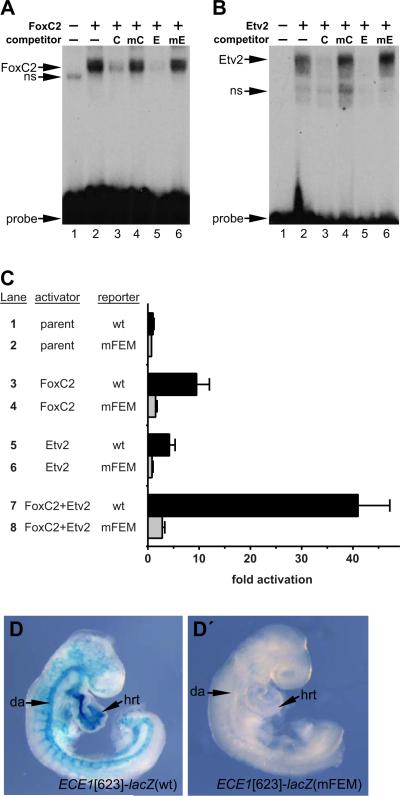FIG. 4.
The ECE1 enhancer contains a bona fide FOX:ETS motif. (A,B) EMSA using a radiolabeled double-stranded oligonucleotide probe encompassing the ECE1 FOX:ETS motif. Recombinant FoxC2 (A) and recombinant Etv2 (B) each bound the site (lane 2). Addition of excess unlabeled control FOX:ETS motif probe [C] or the ECE1 FOX:ETS motif probe [E] abolished binding of FoxC2 and Etv2 (lanes 3, 5). Competitor oligonucleotides in which the FOX:ETS motifs were mutated [mC, mE] did not compete for binding, even when added at ~100-fold excess (lanes 4, 6). Unprogrammed reticulocyte lysate is shown in lane 1 in each panel. Non-specific [ns] bands and free probe are denoted. (C) Cos-1 cells were co-transfected with pRK5 expression vector (lanes 1,2), pRK5-FoxC2 (lanes 3,4), pRK5-Etv2 (lanes 5,6), or pRK5-FoxC2 and pRK5-Etv2 (lanes7,8) and the wild type [wt] ECE1-TK-β-gal reporter (lanes 1,3,5,7) or a version of the reporter with a mutated FOX:ETS motif [mFEM] (lanes 2,4,6,8) and assayed for β-galactosidase activity. FoxC2 and Etv2 each activated the reporter (lanes 3,5). Cooperative activation was observed when FoxC2 and Etv2 were co-expressed (lane7). In all cases, activation was dependent on an intact FOX:ETS motif. Data are expressed as the mean fold activation plus SEM for 3 independent transfections and analyses. (D, D’) Wild type [wt] ECE1[623]-lacZ (D) or ECE1[623]-lacZ with a mutated FOX:ETS motif [mFEM] (D’) transgenic embryos were collected at E9.0 and were X-gal stained to detect β-galactosidase activity. The wild type enhancer was active throughout the arterial vasculature (7/9 independent transgenic lines; 2 lines showed little or no expression). Mutation of the FOX:ETS motif site completely abolished all activity in 3/3 independent transgenic lines examined. Representative transgenic embryos are shown. da, dorsal aorta; hrt, heart.

